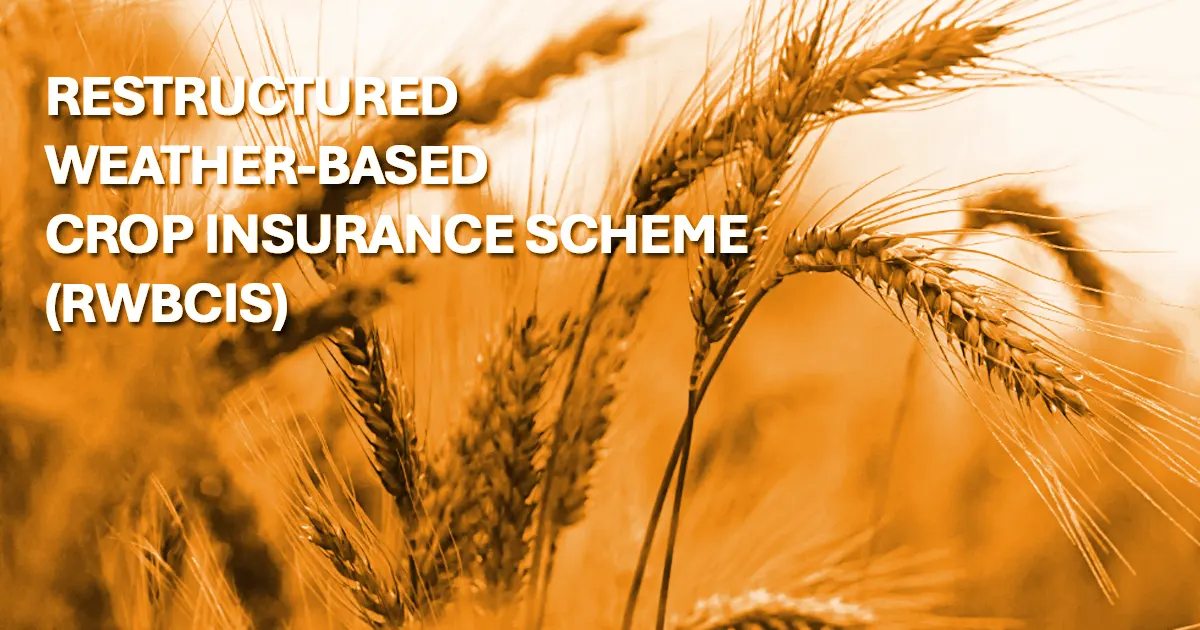GS 3 – AGRICULTURE

The Restructured Weather-Based Crop Insurance Scheme (RWBCIS) is an innovative crop insurance initiative introduced by the Government of India to protect farmers from weather-related risks. It is part of India’s larger strategy for agricultural risk management and complements other insurance schemes like the Pradhan Mantri Fasal Bima Yojana (PMFBY).
Objectives of RWBCIS
- Protect Farmers: Mitigate financial losses for farmers caused by adverse weather conditions.
- Enhance Stability: Provide financial stability to farmers during uncertain weather periods.
- Encourage Technology: Promote the adoption of modern agricultural practices through risk mitigation.
- Ensure Inclusivity: Provide affordable crop insurance coverage to farmers, including small and marginal ones.
Key Features
- Weather-Based Approach:
- Unlike traditional crop insurance, RWBCIS links insurance payouts to pre-defined weather parameters such as rainfall, temperature, wind speed, and humidity.
- If actual weather deviates from the threshold values, farmers receive compensation.
- Crops Covered:
- Kharif Crops: Paddy, maize, cotton, etc.
- Rabi Crops: Wheat, barley, mustard, etc.
- Commercial Crops: Sugarcane, tea, coffee, and horticultural crops.
- Parameters Assessed:
- Rainfall: Deficit, excess, or prolonged dry/wet spells.
- Temperature: High/low temperatures affecting crop growth.
- Humidity and Wind Speed: Factors influencing diseases or crop damage.
- Affordable Premium Rates:
- Farmers pay a subsidized premium, with the government (state and central) covering the remaining cost.
- Efficient Claims Settlement:
- Weather data from Automatic Weather Stations (AWS) ensures objective and transparent claim settlements.
Advantages
- Speedy Compensation: No need for field-level crop damage assessment; payouts are based on weather data.
- Increased Coverage: Encourages participation of farmers who traditionally avoid crop insurance due to complex claim processes.
- Adaptation to Climate Risks: Helps farmers adapt to increasing climate variability by reducing financial uncertainty.
- Supports Marginal Farmers: Provides financial security to vulnerable farmer groups.
Challenges
- Accuracy of Weather Data: Limited number of Automatic Weather Stations (AWS) can affect data precision.
- Awareness Issues: Low awareness among farmers regarding the scheme’s benefits and processes.
- Limited Coverage: May not cover all types of weather-related risks comprehensively.
- Delayed Subsidy Releases: Delay in government subsidy disbursal impacts insurers’ ability to settle claims promptly.
Implementation Agencies
The scheme is implemented through:
- Agricultural Insurance Company of India (AIC).
- Private Insurance Companies.
- Collaboration with state governments.
Comparison with PMFBY
| Feature | RWBCIS | PMFBY |
| Basis of Coverage | Weather parameters | Actual crop loss based on yield. |
| Claim Settlement | Weather data | Crop cutting experiments (CCEs). |
| Premium Subsidy | Government-funded | Government-funded. |
| Key Focus | Mitigating weather risks | Comprehensive crop insurance. |
The Restructured Weather-Based Crop Insurance Scheme (RWBCIS) plays a critical role in reducing the financial vulnerability of farmers to weather-related risks. By ensuring swift and objective compensation, the scheme supports agricultural sustainability and contributes to achieving the goal of doubling farmers’ income. For enhanced effectiveness, challenges such as data infrastructure and awareness need to be addressed.




